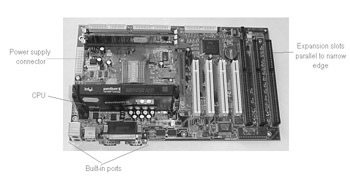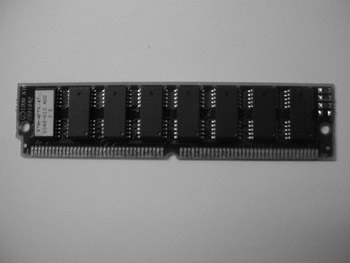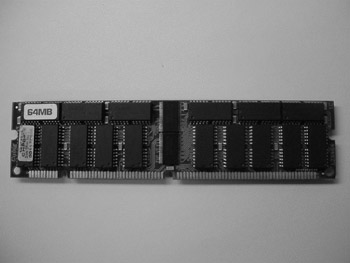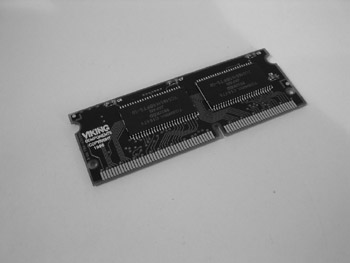Lab 2.1: PC Motherboard Architecture
The A+ exam requires you to be able to recognize many components that make up a PC. It all starts with the kind of motherboard, or form factor, the PC uses. We will cover how to recognize the motherboard form factors and how to identify the components on the motherboard. The primary topic of this section is how to recognize the many different memory packages. Later in the chapter, we will discuss how the operating systems use memory.
Let’s go over some of the concepts you need to understand:
AT Form Factor The AT form factor was designed by IBM. Its distinguishing features include the position of the keyboard plug and the type of power connectors (see Figure 2.1). Problems with the AT form factor include its large size and the lack of other external connectors.

Figure 2.1: AT form factor
Baby AT Form Factor The baby AT form factor was introduced as technology improved and the demand for smaller computers increased. Essentially, the baby AT is the same as the full AT, but it’s significantly smaller. It uses the same power connectors, and its only external connector is the keyboard plug.
ATX Form Factor The ATX form factor incorporates all the external connectors we are familiar with today (see Figure 2.2). The power connector has been changed to a P1 connector, which simplifies the connection and provides continual power to the motherboard. The size of the ATX motherboard remains small, like the baby AT.

Figure 2.2: ATX form factor
CMOS/BIOS The Complementary Metal Oxide Semiconductor (CMOS) chip houses a set of programming instructions called the Basic Input/Output System (BIOS). Because this is the only function of the CMOS chip, the names are almost interchangeable. The BIOS runs the programs that allow the computer’s devices to communicate with the CPU. The CMOS setup routine allows you to interface with these programs to configure the devices in the computer.
Flash ROM This fills the same function as the CMOS. The main difference is that you can reprogram the chip without removing it. Flash ROM gives you the flexibility to update the BIOS when new technologies emerge. It has become the primary chip used today. Visually, it is difficult to distinguish between the older CMOS and today’s Flash ROM chips.
CPU Socket Luckily, the exam doesn’t expect you to be able to visually recognize the differences between the many CPU sockets that have been created over the years for all the different processors. It does, however, require that you be able to identify which processors are associated with the different sockets. Visually, you have to be able to identify a Zero Insertion Force (ZIF) socket and a Slot 1 socket, which uses the Single Edge Processor (SEP), on the motherboard.
RAM Bank Random access memory (RAM) is the working memory of the computer. It has undergone many improvements over the years. The most visible of these improvements is in the packaging and the way memory banks are populated. Memory was first packaged with DIPPs; the latest packaging uses memory sticks. The exam will ask questions that test your ability to recognize the different packages.
DIPP Dual Inline Pin Packages (DIPPs) were the first generation of dynamic random access memory (DRAM). A DIPP consisted of a chip with two rows of pins that were pushed into the sockets on the motherboard (see Figure 2.3). The memory bank consisted of rows of DIPPs.

Figure 2.3: Dual Inline Pin Package (DIPP)
SIPP Single Inline Pin Packages (SIPPs) simplified the installation of memory. Instead of installing multiple DIPPs to create a bank of memory, you could install sticks of memory (see Figure 2.4). Each bank consisted of two sticks; each stick had the DIPPs soldered to the stick. The motherboard had special sockets for the installation of the stick.

Figure 2.4: 30-pin SIPP
SIMM 30-pin Single Inline Memory Modules (SIMMs) were the next improvement in memory packaging (see Figure 2.5). The pins were removed to simplify installation. The number of sticks needed to create a bank varied based on the external data bus. The 16-bit data bus used two sticks, the 32-bit data bus used four sticks, and the 64-bit data bus used eight sticks per bank.

Figure 2.5: 30-pin SIMM
With the 32-bit data bus, 72-pin SIMMs grew in popularity (see Figure 2.6). The major improvement was that the sticks of memory were also 32 bits wide. This meant few sticks were needed to complete a data bank. Each stick of 72-pin SIMMs was the equivalent of four 30-pin SIMMs. The distinguishing factor was that the sticks were longer and had a notch in the center.

Figure 2.6: 72-pin SIMM
DIMM SIMMs were replaced by Dual Inline Memory Modules (DIMMs). The first DIMMs were nothing more than two SIMMs on the same stick. The number of pins increased to 168, and the data bus is 64 bits wide (see Figure 2.7). The physical characteristics now include two notches to make installation easier. This package is the current package for memory. All of the new types of memory—SDRAM, EDO, and DDR SDRAM—are packaged the same.

Figure 2.7: 168-pin DIMM
SoDIMM Laptops had their own problems with memory packaging. The solution for laptops was the introduction of the Small Outline DIMM (SoDIMM), which makes accessing and installing RAM a simple process (see Figure 2.8).

Figure 2.8: SO-DIMM
Upon completion of this lab, you will be able to:
-
Recognize the motherboard form factors.
-
Identify the components of the motherboard.
-
Be familiar with the various memory packages.
Set Up
For this lab, you will need a working computer.
Exercise
In this lab you will open a PC and document its components, such as the location and type of the CPU, RAM, and BIOS.
-
Take the cover off your computer. Examine the motherboard.
-
Make a drawing of the motherboard and its components.
-
Label each component on the drawing.
-
Record the name of the BIOS:
-
Record the type of processor:
-
Record the type of RAM and the RAM package:
- Chapter V Consumer Complaint Behavior in the Online Environment
- Chapter XI User Satisfaction with Web Portals: An Empirical Study
- Chapter XIII Shopping Agent Web Sites: A Comparative Shopping Environment
- Chapter XV Customer Trust in Online Commerce
- Chapter XVIII Web Systems Design, Litigation, and Online Consumer Behavior